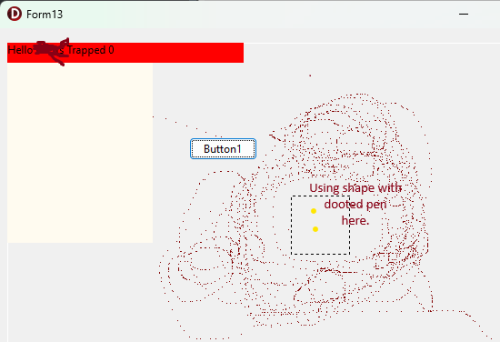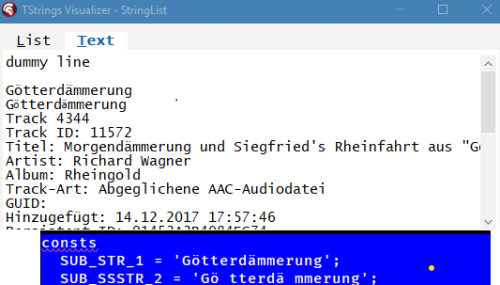

Pat Foley
-
Content Count
440 -
Joined
-
Last visited
-
Days Won
2
Posts posted by Pat Foley
-
-
This is one place using the IDE Insight helps greatly. In the design window.
- use <F6> if your fingers are on the top row of the keyboard.
- or simply the <Ctrl .> if closer to bottom row.
- type in Control name or Class type of control.
- Select with Enter Key.
- Press <F11> then the Object inspector finder is focused and type in property to edit.
Or simply tab thru the controls, moving/sizing them with control keys Shift or Ctrl with the arrow keys. Avoiding this practice in your case by simply pressing <F11> key instead. (Also verifies the tab order)
Or the Structure panel is either mouse able or arrow keys to avoid touching the controls with mouse in the design window.
Or View revisions by selecting Alt-F12 and select History there. 🙂
-
 2
2
-
5 hours ago, david berneda said:So A and B don't know and don't use each other directly or indirectly, but the end result is for example a tabsheet created in B is displayed in A.
Use class names vs class types to avoid adding B in uses clauses. Existing controls and forms are renamed to fit existing inifile naming scheme. And as the controls loaded, if their parent is not found, they make one--example a Serie or line needs a Chart if not found we make a chart parenting it to the named form or control. So all Tee.* is only in
mainformBOSS uses. letting the Boss code update the charts and legends parented elsewhere.Use ComponentClass and add "fixup" and parenting later for UI controls and List<TMyControl>for non-visual controls.
A startup inifile is embedded in file to allow the program to run in "Demo" when inifile not found. Mainly to build menu and tree Navigation. But more importantly reduce the need for global variables by using 'names'.
Then with empty uses clauses we stick in a DM needed to share Imagelist. and a Boss unit that reads in the controls needed.
-
To fix your example set the tabstop to False on the Edit controls. Better to set the Key = 0 when Key = VK_RETURN is handled to let the focus move to next control (Excel style moves to next cell on enter). More important is have the tabs z-order end at a submit button that confirms the entries. Sample's editkeydown handles the Edits and a Listbox to let the user select the right item the first time rather a screen that covers not only the app but other running apps to fix typos. Also the InputBox allows an edit of its items.
procedure TForm1.EditKeyDown(Sender: TObject; var Key: Word; Shift: TShiftState); var ii : Integer; s :string; begin var MoreZ := not (ssShift in Shift); if (Key = VK_RETURN) and (Sender is TEdit) then begin Key := VK_Tab; var Edit := Sender as TEdit; if not MoreZ then Edit.text := InputBox('Fixer', '?', Edit.text); SelectNext(Edit,MoreZ,True); end; if (Key = VK_RETURN) and (Sender is TListBox) then begin Key := VK_TAB; var LB := TListBox(Sender); SelectNext(LB,MoreZ,True); ii := LB.ItemIndex; if ii > -1 then s := LB.Items[ii] else begin s := 'Select something in' + LB.Name; MoreZ := True; end; if MoreZ and (ii > -1) then LB.Items[ii] := InputBox('lister', '?', s); end; end;
-
Did you use Turbo pascal Programmers Library by Jamsa back then and and how about Ready-to_Run Delphi 3 Algorithms both mention using generic coding for code reuse back then should help in learning code reuse and simply reusing someone else code now. Tstringlist.Commatext may be able to lift your old code and Format('%s,%,s', ['name', Number.tostring])to feed Stringgrid.Rows[0].commaText := 'name,Number';
-
18 hours ago, Freeeee said:I got the idea from Microsoft. There year zero date is 01/01/1980.
mine is 01/01/0000 . good in a long integer (and a 5 digit year) until 31,999/12/31.
mmm, I run win 11 are you still using DOS.
procedure TForm16.Button4Click(Sender: TObject); var SL: TStrings; // F1 click bait begin SL := memo1.Lines; for var aDate in [0, 1,2,3, 30000-2*365-32-17 , 30000, 40000, 50000, 100000] do begin SL.Add(DateToStr(aDate)); end; end;
-
1 hour ago, Stano said:
Note 2: in such cases I use a list of components. Your TLabel. Then you just need to do everything in a loop. And not list every Tlabel and line of the Tmemo.By switching to Static text like a label but the advantage of windows handle so it be selected then you add a event to the win control like so. F2 is an Edit control. I'm sure Marco Cantu has much examples in his books.
procedure TForm16.Clicker(Sender: Tobject); begin EZ := F2.Text; (Sender as TStaticText).Caption := EZ; end; procedure TForm16.RzButton1Click(Sender: TObject); var Labels: Array[0..9] of TStaticText; var stlabela: TStaticText; begin var count:= 0; for var stlabel in Labels do begin Labels[Count] := TStaticText.Create(Self); stlabela := Labels[Count]; stlabela.Parent := self; stlabela.SetBounds(24,20*count,50,23); stlabela.onClick := Clicker; stlabela.Caption := count.ToString; stlabela.Show; Inc(count); end; end;
-
I actually looked at some JS code and Physics for Game Developers by Bourg for stuff on Quaternions. The Model-3D sample may be a start.
Years ago at a talk about making the Matrix movie the speaker said the stuff in background was all 2D "decals". And it takes three years of schooling for 3D. (Also even a graphic artist needs know linux to get hired.)
procedure TModel3DTest.Form3DMouseMove(Sender: TObject; Shift: TShiftState; X, Y: Single); begin if (ssLeft in Shift) and Mouse then begin DummyX.RotationAngle.X := DummyX.RotationAngle.X - (Y - Down.Y)* 0.3 ; DummyY.RotationAngle.Y := DummyY.RotationAngle.Y + (X - Down.X)* 0.3 ; Down.X := X; Down.Y := Y; end; end;
-
What making One Application for now. And Run it Three times at a time.
set the Parameters Data1.dat , Data2.dat, Data3 for first app.
set the Parameters Data2.dat , Data3.dat, Data1 for Second app.
set the Parameters Data3.dat, Data1.dat, Data2 for Third app.
... procedure FindDeltas( const Param{1}, Param(2), Param(3)); begin Old code in here end;
Is it a lazy steer that its 'looking' at?
-
What version I using 12.2 and tried this IDE insight and it works well with the keyboard.
- start Delphi
- Press <F6> and enter VCL
- Using down arrows select Windows Application
- Press<F6> enter VCL select VCL form
- Press<F6> Enter TButton
- Repeat above as needed.
- Press<F6> Enter Help
-
5 hours ago, Anders Melander said:QuickJS is a javascript engine while pas2js is a transpiler that emits javascript.
Not even remotely the same thing.
You are right. The files to look at is web.pas has var dom, console, and window. The js.pas uses JSValue and parses JSON objects unsure if the eval can do multiline.
-
-
2 hours ago, PeterBelow said:One thing too keep in mind is the fact that form variables created by the IDE do not get assigned any form reference if the unit is part of a package and the form is also not autocreated. If you create the form in code it is your responsibility to assign the created form reference to the variable if you intend to use it (which is a bad idea in the first place IMO).
Would not using global variables for any forms and using unique name for forms to use make it a better idea. To reduce complexity a TreeView is loaded in mainform with nodes referencing the forms being created. The Treeview can then be parented to the Active form to let the user navigate the app readily. A DM can help surfacing the data through the UI.
-
You might to study and use this to move cursor to control being selected. I want to add it to IDE <F6> or <Ctrl>. function it only jumps to selection without any animation 🙂
procedure TTaskmaster.moveMouse(AtaskDetail: TInstruction); var x, y, MouseXError, MouseYError: integer; ControlCenter: Tpoint; AC: TControl; begin findControl(AtaskDetail, AC); if not assigned(AC) then exit; if assigned(AC.Parent) then AC.Parent.Show; AC.Show; x := AC.ClientOrigin.X + AC.width div 2; y := AC.ClientOrigin.y + AC.height div 2; begin MouseXError := round(1.12 *(x - mouse.CursorPos.X)); MouseYError := round(1.12 * (y - mouse.cursorPos.y)); // MouseXError := min(MouseXError, 10 * sign(MouseXError)); // MouseYError := min(MouseYError, 10 * sign(MouseYError)); controlCenter.X := mouse.CursorPos.x + MouseXError; controlCenter.Y := Mouse.CursorPos.y + mouseYError; mouse.CursorPos := ControlCenter; end; repeatTask := (abs(MouseXError) > 7) or (abs(MouseYError) > 7); end;
-
This should yield control asked for.
procedure TTaskMaster.findControl(AtaskDetail: TInstruction; var AC: TControl); var ff, ii : integer; sForm, sControl: string; begin with AtaskDetail do begin if Control <> nil then AC := Control else begin sForm := controlForm + ' not found.'; sControl := controlName + ' not found.'; //screens move about on windows list top window usually 0 :( for ff := 0 to Screen.FormCount - 1 do if Screen.Forms[ff].name = controlform then begin sform := controlForm; with Screen.Forms[ff] do begin for ii := 0 to componentcount - 1 do if Components[ii].Name = ControlName then begin sControl := controlName + ' comps ' + ii.ToString; Control := Components[ii] as Tcontrol; //onBS(False, format('Item %d Found %s',[ii,controlName])); break; end //else//if name //run := false; // onBS(False, format('Item %d not found %s',[ii, controlName])); end;// with screen forms end; //if screen.forms onBS(False, sForm + ' ' + sControl); end;// else end;//with taskdetail end;
What TInstruction is
TInstruction = class //position in Db Atom: PAtom; Control: TControl; ControlForm: string; //3 ControlName: string; //2 Description: string;//6 //Nu: integer; //0 Kind: string; //1 was integer KindNU: integer; referenceValue: Double;//5 tagName: string; //4 tagValue: Double; //no data in table end;
-
One thing about XML is on a treeview each node needs a unique caption so as tabSheets or the parent of control wanted are added a number is added to the node's caption as the forms are added.
Second thing is the Control could have data reference added.
type // On the UI controls side carry some data references for convenience // the data side could use Dependance Injection to tie in UI controls TDataButton = class(TButton) Form: TControl; Strs: TStrings; end;
What's neat about MDI you can create a new childform inside a begin..end. To access the form elsewhere use Application.Screen
-
I used the code for reverse phone lookup that's for an xxx with xx,xxx outlook accounts.
You need to make a custom list of clients, a Client group email and ... then as employees come and go you add remove their access to the companies Client email account.
Or you could enhance your application by logging when clients are added, contacted, removed from client list. I sent out emails and SMS each week to departments as client schedules were updated.
-
Again I would use OutLook to make the output using export.
example mapping
https://jkp-ads.com/rdb/win/s1/outlook/mail.htm
Also here is some old (2017) Excel code from Ron's earlier site
Sub DemoAE() Dim colAL As Outlook.AddressLists Dim oAL As Outlook.AddressList Dim colAE As Outlook.AddressEntries Dim oAE As Outlook.AddressEntry Dim oExUser As Outlook.ExchangeUser Set colAL = Outlook.session.AddressLists '("Offline Global Address List") For Each oAL In colAL 'Address list is an Exchange Global Address List If oAL.AddressListType = olExchangeGlobalAddressList Then Set colAE = oAL.AddressEntries For Each oAE In colAE If oAE.AddressEntryUserType = _ olExchangeUserAddressEntry _ Or oAE.AddressEntryUserType = _ olExchangeRemoteUserAddressEntry Then Set oExUser = oAE.GetExchangeUser ' Debug.Print (oExUser.JobTitle) ' Debug.Print (oExUser.OfficeLocation) ' Debug.Print (oExUser.BusinessTelephoneNumber) ' Range("A1").Offset(X, 1) = oExUser.JobTitle Range("A1").Offset(X, 9) = oExUser.ID 'OfficeLocation Range("A1").Offset(X, 8) = oExUser.MobileTelephoneNumber 'HomeTelephoneNumber Range("A1").Offset(X, 7) = oExUser.Name 'Range("A1").Offset(X, 5) = oExUser.PrimarySmtpAddress X = X + 1 End If Next End If Next End Sub
-
-
One way is save as .pst file or .csv file inside of Outlook.
Second way is use VBA to learn the names of methods that Outlook uses to save lists in different formats.
-
I think the issue lies in the coding, each series properties needed be updated consistently. This example shows renaming the series and the labels to allow a consistent means of updating the control. Consistently meaning each control deals only with the data it was named and Created for.
procedure TForm1.Button1Click(Sender: TObject); const labelAft = 'Afternoon'; labelNite = 'Nite'; labelDay = 'Day'; ShiftDayFraction = 8/24; clNite = clRed; var seDay, seAfternoon, seNight: TGanttSeries; begin seDay := Series1; seAfternoon := Series2; seNight := Series3; seNight.Clear; seDay.Clear; seAfternoon.Clear; var addC: Boolean := CheckBoxBreakLabels.Checked; var startDate: TDateTIme := Now; startDate.SetTime(4, 0, 0, 0); seDay.AddGanttColor(startDate + ShiftDayFraction, startDate + 2 * ShiftDayFraction, 1, labelDay, clGreen); if addC then seAfternoon.AddGanttColor(startDate + 2 * ShiftDayFraction , startDate + 3 * ShiftDayFraction, 3, labelAft, clBlue); seNight.AddGanttColor(startDate, StartDate + ShiftDayFraction, 2, labelNite, clNite); // seNight.AddGanttColor(startDate, StartDate + ShiftDayFraction, 1, 'Sametimeline', clNite); end;
-
So that it is found in the controls list of the control or component vs the components list of a form or application.
-
 1
1
-
-
Somewhere I have a control that draws a focus rect and tests rect intersect of all controls in componentlist to add to selected list. Just as lost is a control that draws a connector between selected controls using clienttoscreen. I will look for the controls later.
I'll attach the mention control. Depending how you assign the mouse events either drop on the form or resize it manually the TCustomPanel does not have the align prop. Unsure why I was drawing the focus rect with DC back then.

I use a Tshape brush style set to bsClear and pen dotted line now.
-
To reveal the markers add to source or set in Object Inspector
BorderWidth = 5
-
6 hours ago, Tom Mueller said:I noticed that you reduce the size of the sub-control to display the markers correctly.
I should have included this
procedure TTestSelectMarker.WMSIZE(var message: TWMSIZE); begin // FPanel.setbounds(10,10,Width- 2 * 10, Height - 2 * 10); Fpanel.Align := alClient; end;
![Delphi-PRAXiS [en]](https://en.delphipraxis.net/uploads/monthly_2018_12/logo.png.be76d93fcd709295cb24de51900e5888.png)




Where is GetTickCount64 in Delphi XE7
in General Help
Posted
gOOGLE speculates Xe7 in System.Classes has TThread.GetTickCount64;